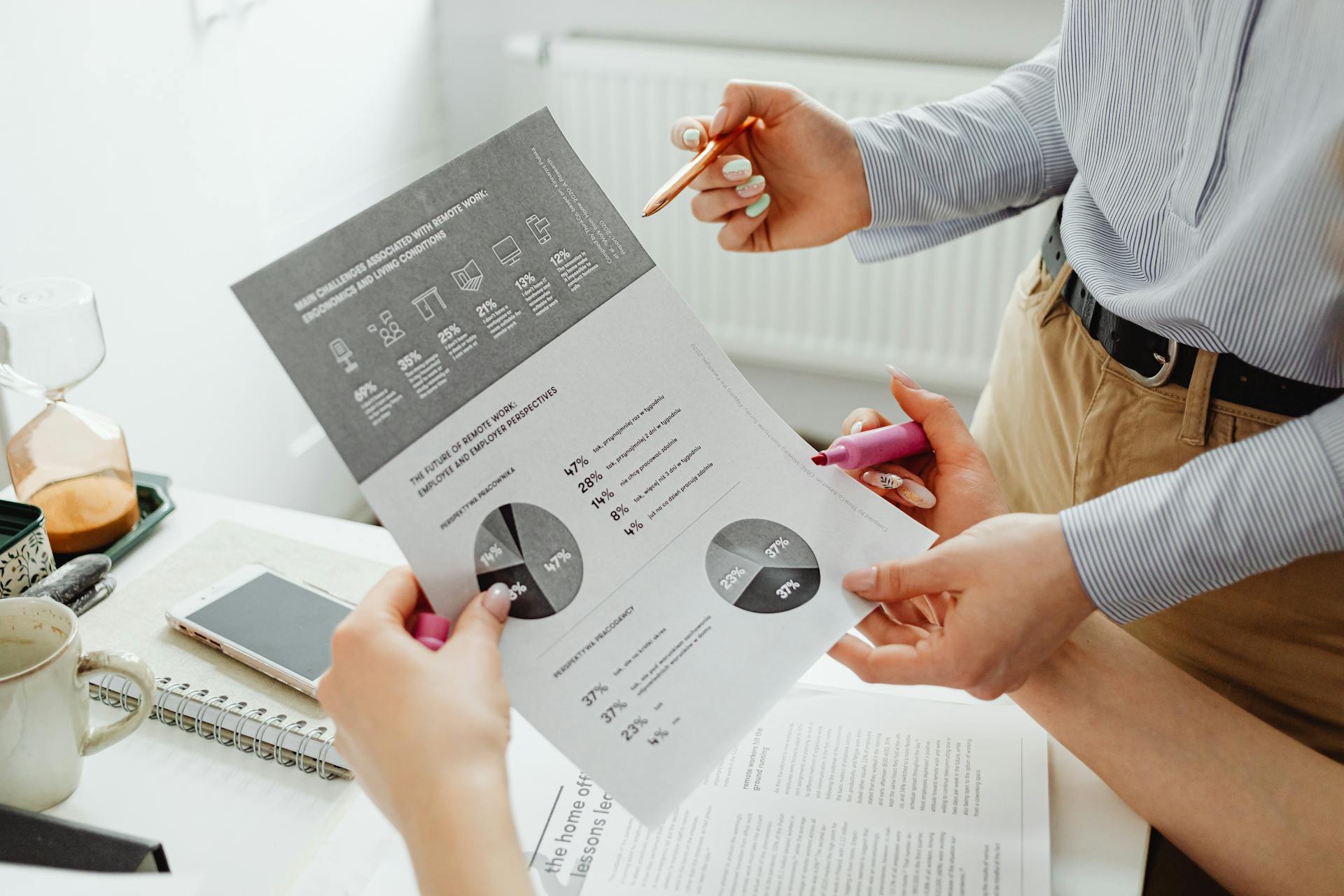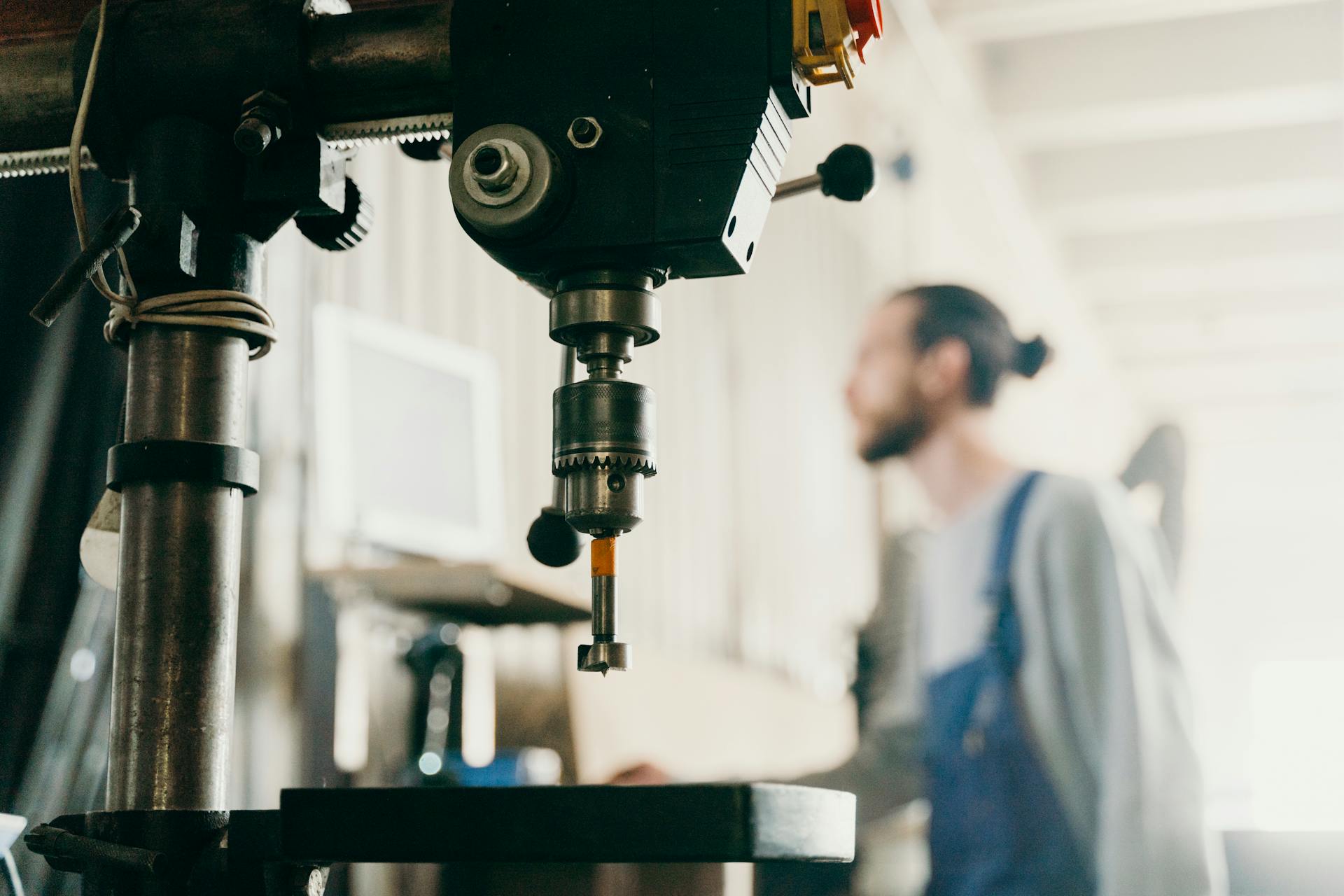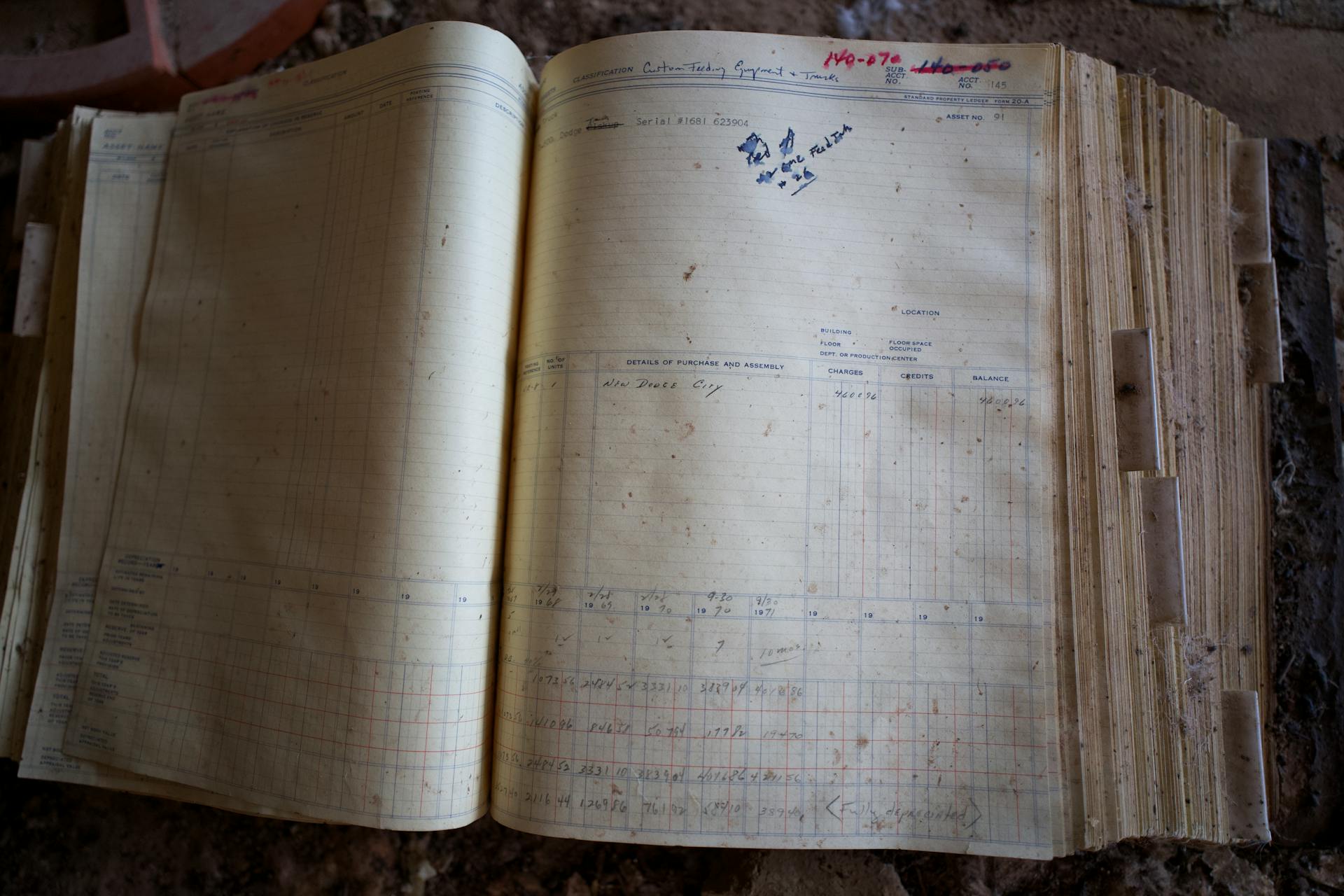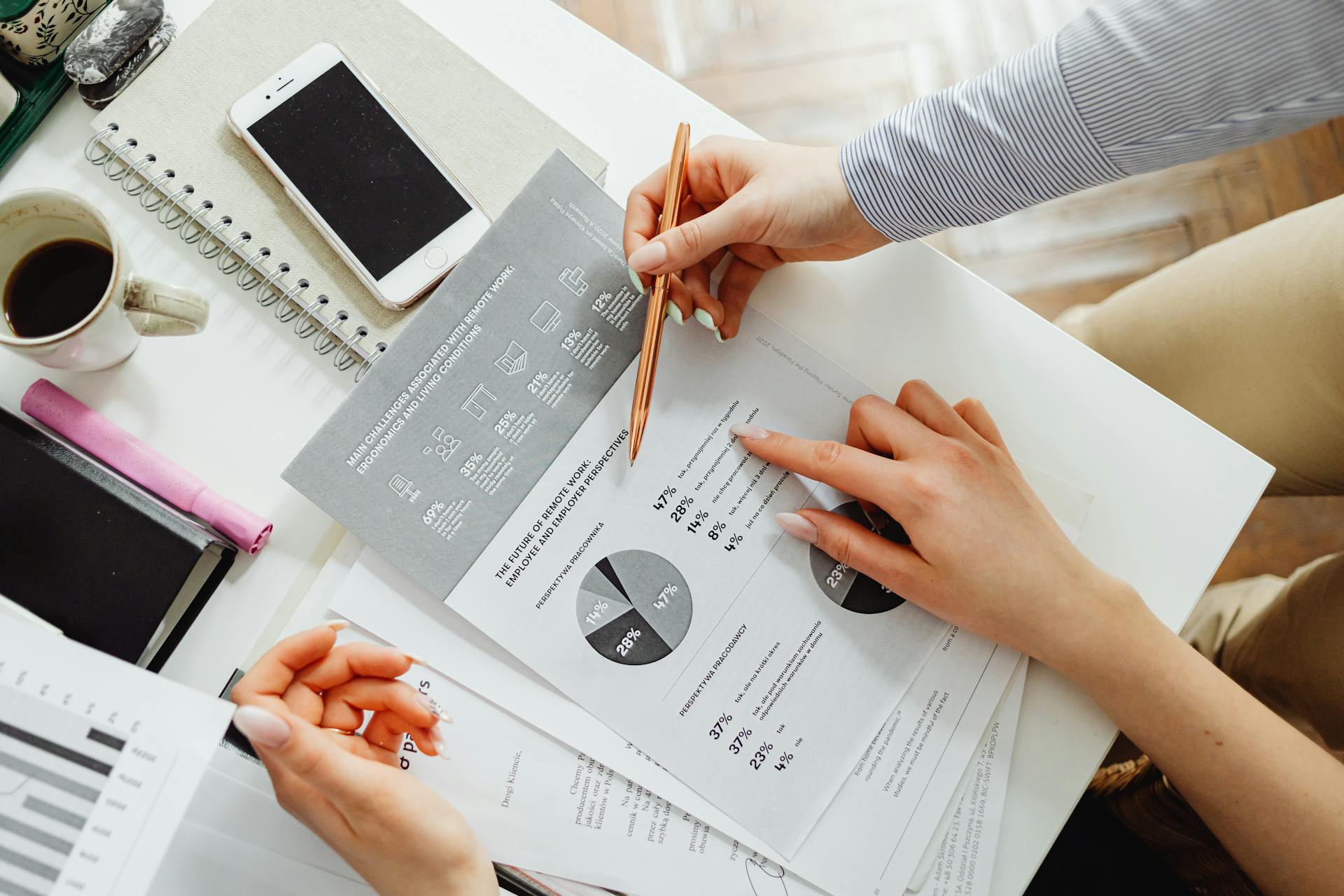
Accumulated depreciation is often misunderstood as a separate asset on a company's balance sheet, but is it really? According to the accounting standards, accumulated depreciation is actually a contra asset account, which means it has a negative value and is used to reduce the carrying value of a tangible asset.
It's not a separate asset because it doesn't represent a specific resource or piece of property, but rather a reduction in the value of an existing asset. This is in contrast to other assets like cash or inventory, which have a positive value.
In accounting, accumulated depreciation is recorded as a separate line item on the balance sheet, but it's not an asset in its own right. It's a way of tracking the decrease in value of an asset over time.
If this caught your attention, see: Why Land Not Depreciated
What is Accumulated Depreciation?
Accumulated depreciation is a contra asset account that represents the total amount of depreciation expense recorded by a company over time. This account is used to reduce the carrying value of tangible assets, such as property, plant, and equipment, to their net book value.

Depreciation expense is calculated by subtracting the residual value of an asset from its cost, and then dividing the result by its useful life. For example, if a machine costs $10,000 and has a residual value of $2,000 and a useful life of 5 years, the annual depreciation expense would be $1,600.
Accumulated depreciation is not an asset in the classical sense, but rather a reduction in the value of an asset. It's a way to reflect the decrease in an asset's value over time due to wear and tear, obsolescence, or other factors.
Readers also liked: Is Whole Life Insurance an Asset
Calculating Accumulated Depreciation
Calculating Accumulated Depreciation is a straightforward process that involves looking at the company's balance sheet.
Accumulated depreciation is typically shown just below the company's fixed assets.
You may need to dig deeper if the balance sheet only lists "Property, plant, and equipment – net", which shows the book value of the company's assets, net of accumulated depreciation.
In this case, you can find more details about the book value of the company's assets and accumulated depreciation in the financial statement disclosures.
Accumulated Depreciation in Financial Statements

Accumulated depreciation is a contra-asset account that appears on the balance sheet, offsetting the corresponding fixed asset.
It directly impacts the reported book value of the assets, which is the value of the assets as recorded on the balance sheet.
The accumulated depreciation maintains a historical record of all depreciation expenses, which is crucial for reporting the true value of the fixed assets owned by the company.
Depreciation expense is reported on the income statement and reduces the company's net income, reflecting the true economic cost of using the asset to generate revenue.
Accumulated depreciation affects financial ratios and performance metrics, which are used to evaluate a company's financial health and performance.
It's essential to distinguish between accumulated depreciation and depreciation recorded in a specific period, as the latter appears on the income statement.
For more insights, see: How Does Depreciation Affect Cash Flow Statement
Examples in Practice
Accumulated depreciation is a real-world phenomenon that affects businesses and assets alike.
In practice, companies like to calculate annual depreciation expenses using the straight-line method, which involves dividing the asset's depreciable cost by its useful life.

This method is straightforward and easy to apply, making it a popular choice among businesses.
For instance, if a company buys a machine for $10,000 with a useful life of 5 years, the annual depreciation expense would be $2,000.
The declining balance method, on the other hand, results in higher depreciation expenses in the earlier years.
In this method, a fixed percentage of the asset's book value is depreciated each year, rather than a fixed amount.
As a result, the asset's book value decreases more rapidly in the early years, which can have a significant impact on the company's financial statements.
Accumulated depreciation is also an important consideration when it comes to asset disposal or resale.
The accumulated depreciation reflects the asset's true value after considering the wear and tear over time, impacting its resale or disposal value.
For example, if a company sells an asset with a remaining useful life of 2 years, the accumulated depreciation would be subtracted from the asset's original cost to determine its sale price.
For more insights, see: Journal Entry for Disposal of Asset Not Fully Depreciated
Methods and Techniques

Accumulated depreciation can be calculated using six accepted methods under generally accepted accounting principles (GAAP). These methods include the straight line, declining balance, double-declining balance, sum-of-the-years' digits, units of production, and half-year recognition.
A company can choose from these methods to calculate depreciation, but it's essential to consider the asset's nature, expected usage, and the most accurate reflection of its decline in value over time. This informed choice helps present a fair and accurate portrayal of the company's financial position.
The accelerated depreciation method, such as the double-declining balance, allows for higher depreciation earlier than the straight-line method. This can impact the timing and amount of depreciation charges and the financial statements.
Here are the six accepted methods for calculating depreciation:
- Straight line
- Declining balance
- Double-declining balance
- Sum-of-the-years' digits
- Units of production
- Half-year recognition
Purpose
The purpose of methods and techniques is to achieve specific goals and outcomes in various fields and industries.
Effective methods and techniques can help individuals and organizations solve complex problems and improve their performance.

According to research, the use of structured methods can increase productivity by up to 30%.
A well-defined technique can also help to reduce errors and improve the quality of work.
In fields like engineering and science, methods and techniques are used to design and test new products and systems.
The purpose of experimentation is to test hypotheses and gather data to inform decision-making.
Experimentation can be used to validate or invalidate assumptions, and to identify areas for improvement.
By using systematic and rigorous methods, researchers can increase the validity and reliability of their findings.
Methods to Calculate
There are six accepted methods for calculating depreciation under generally accepted accounting principles (GAAP). These methods include the straight line, declining balance, double-declining balance, sum-of-the-years' digits, units of production, and half-year recognition methods.
The straight line method depreciates an asset at an equal amount over each year in its life. For example, if a company purchases a mobile grooming van for $60,000 and depreciates it over five years, $12,000 of accumulated depreciation is recorded per year.
For your interest: What Is Prior Year Accumulated Depreciation

The declining balance method records depreciation as a percentage of the asset's current book value. This means that the amount of depreciation decreases each year, even though the total accumulated depreciation increases. For instance, if a company depreciates 20% of the book value each year, the amount of depreciation decreases over time.
The double-declining balance method is an accelerated depreciation method that doubles the depreciation rate used in the straight-line method. This results in higher depreciation charges earlier in the asset's life. For example, if a company uses the double-declining balance method with a 10% depreciation rate, it would recognize $24,000 in depreciation in the first year.
Here are the six accepted methods for calculating depreciation:
- Straight line
- Declining balance
- Double-declining balance
- Sum-of-the-years' digits
- Units of production
- Half-year recognition
Methods and Techniques
Accumulated depreciation is a contra-asset account that offsets the balance of the asset account it's associated with.
Contra-asset accounts work in the opposite direction of standard asset accounts, where credits increase the value and debits decrease it.
For another approach, see: What Accounts Are Current Assets

Accumulated depreciation is typically shown in the Fixed Assets or Property, Plant & Equipment section of the balance sheet.
It's essential to separately state accumulated depreciation on the balance sheet to give readers of financial statements more information about the company.
Accumulated depreciation is not a current asset, as current assets aren't depreciated because they aren't expected to last longer than one year.
To zero out the accumulated depreciation account, a company would credit the asset account and debit the accumulated depreciation account.
This is done when an asset is no longer relevant to the company, such as when it's sold.
You might like: T Account Debit Credit
Amortization
Amortization is a process that works in the same way as depreciation and depletion, all being contra-asset accounts.
These accounts are used to record the reduction in value of intangible assets like patents, licenses, or trademarks over time.
Accumulated amortization is the contra-asset account that corresponds with amortization expense, and it's credited when the expense is recorded for the year.
It's used to account for the decrease in value of these intangible assets, making it an essential part of financial record-keeping.
Amortization expense is recorded for the year, and the corresponding accumulated amortization account is credited in the process.
For another approach, see: Is Accounts Recievable a Current Asset
Frequently Asked Questions
How do you record accumulated depreciation?
To record accumulated depreciation, you credit a contra asset account. This is typically done in conjunction with debiting a depreciation expense account.
Sources
- https://www.investopedia.com/terms/a/accumulated-depreciation.asp
- https://www.asset.accountant/blog/what-is-accumulated-depreciation-and-how-to-calculate-it/
- https://www.taxfyle.com/blog/understanding-accumulated-depreciation
- https://www.bench.co/blog/accounting/accumulated-depreciation
- https://corporatefinanceinstitute.com/resources/accounting/accumulated-depreciation/
Featured Images: pexels.com

